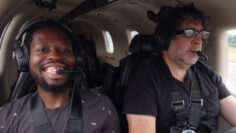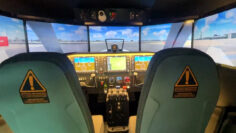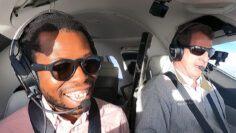Can Planes Fly in the Rain?
If you’ve ever wondered about the intriguing question, “Can planes fly in the rain?” then this article is for you. We’re taking a deep dive into how wet weather impacts the intricate world of aviation. As you might guess, flying in the rain isn’t a simple “yes” or “no” situation. It’s a complex process filled with challenges, but our pilots and aviation experts have all the tools they need to tackle this feat.
The Impact of Rain on Aircraft
Rain’s Effect on Aerodynamics
Picture an aeroplane soaring through the sky. It’s a perfect example of physics at work, especially the principles of lift and drag. Now, introduce rain into the equation, and it changes the ballgame. The falling droplets can alter the smooth airflow over the wings, thus affecting the lift. It’s akin to trying to jog in a swimming pool; the resistance changes your pace and movement. The same concept applies here. More raindrops lead to increased drag, impacting the plane’s speed and handling. But remember, pilots, are trained for these scenarios, so there’s no need for panic!
Rain and the Aircraft Systems
An aircraft is a complex machine, and rain can throw a few spanners in the works. The electrical systems are one concern. Any unexpected water seeping in can cause potential hiccups. Just think of how you wouldn’t use your hairdryer in the shower! Then, there are the Pitot-static instruments that help pilots determine airspeed and altitude. A buildup of rain can lead to incorrect readings, which is not something you want mid-flight. Lastly, let’s not forget about ice. Rain can mess with the anti-icing and de-icing systems, potentially causing ice to accumulate in cold conditions. It’s a lot like your car’s windshield in winter; if your defroster isn’t working, visibility becomes a problem.

The Intricacies of Flying in Light Rain
Aircraft Capabilities and Design Features
Now, it’s not all doom and gloom. Planes are incredibly robust and come equipped with features designed to combat rain. From rain-repellent coatings on the windshield to specialized wing design, aircraft are built to withstand light rain. So, you can rest easy knowing that light showers won’t significantly hamper your travel plans!
The Role of the Pilot
When navigating through light rain, pilots become our heroes. They’re akin to weathermen, relying on forecasts and visibility reports. They use this data to make crucial decisions about flight feasibility. There’s a chance they may need to adjust their takeoff and landing techniques to account for wet runways. It’s all in a day’s work for these skilled professionals!
Regulatory Measures and Guidelines
Thankfully, aviation isn’t a free-for-all. Regulatory bodies like the FAA keep everything in check. They outline essential maintenance routines and inspections that guarantee aircraft systems are rain-ready. It’s their way of ensuring every flight in light rain is as safe as possible.
The Challenges of Flying in Heavy Rain
Navigating the Storm
Heavy rain is where things get a bit tricky. Reduced visibility is the main issue here. Think of driving in a downpour where your wipers can’t keep up. It’s harder to see, right? The same applies to pilots. Wet runways also pose a risk. Too much water can lead to hydroplaning, a situation where the aircraft’s tires lose contact with the ground. It’s similar to skidding on a wet road. Additionally, aerodynamics can take a beating due to the heavier precipitation.
Pilot Expertise and Training
Flying in heavy rain demands more from our pilots. But don’t worry, they’re up to the task! Pilots receive extensive training to tackle these adverse weather conditions. It’s like being a master of a ship in a storm. They have to make vital decisions, possibly even changing course to ensure everyone on board stays safe.
Safety Measures and Regulations for Heavy Rain
In adverse weather, aircraft maintenance and safety regulations become even more crucial. Regular checks and adherence to manufacturer guidelines are a must for ensuring flights can safely traverse through heavy rain. As they say, it’s better to be safe than sorry!

Frequently Asked Questions
Can planes fly through thunderstorms?
Flying through a thunderstorm? That’s a no-go. Thunderstorms are nature’s powerhouses, with strong winds, severe turbulence, and intense lightning. Pilots and air traffic controllers work in harmony to navigate these storms. They may even delay the flight or change the route altogether, keeping everyone’s safety the top priority.
Is flying in rain more dangerous than flying in clear weather?
There’s no denying that rain can throw a few challenges into the mix. Reduced visibility, increased runway risks, and changes in aircraft performance are just a few examples. But it’s not necessarily more dangerous. Our pilots are highly trained, and they follow stringent procedures and regulations to ensure safety remains paramount, regardless of the weather.
What happens if a plane encounters heavy rain during the flight?
If a plane encounters heavy rain mid-flight, it’s all hands on deck. The pilot must rely on their training and experience to maintain control. They may need to lean on instruments and automated systems a bit more. They might also need to adjust the plane’s speed and configuration to counteract the increased drag and reduced lift. Rest assured, communication with air traffic control remains a constant, ensuring they have the most recent weather updates and guidance.
Conclusion
Planes can indeed fly in the rain, but it’s not without its unique set of challenges. Whether it affects the aerodynamics or the aircraft systems, the rain demands some adjustments to flight operations. But with expert training, stringent regulations, and a little bit of on-the-fly decision-making, pilots can navigate these wet conditions successfully. At the end of the day, it’s all about understanding the dynamics at play and ensuring the safety of everyone on board.
Your Turn
We hope you found this deep dive into the world of flying in the rain both informative and insightful. What are your thoughts on this topic? Have you ever experienced a rainy flight? We’d love to hear your stories and answer any further questions you might have. And don’t forget to share this article with others who might find it interesting. We look forward to continuing the conversation in the comments section below! Also, don’t forget to check out our recent article on “The Ferrari Of The Skies. Piaggio P.180 – Aircraft and Turboprop Airplanes.” It’s an exciting read that delves into innovative technologies and advancements in aircraft design. Discover the world of turboprop aeroplanes and the incredible capabilities of the Piaggio P.180. We’re sure you’ll find it fascinating!







